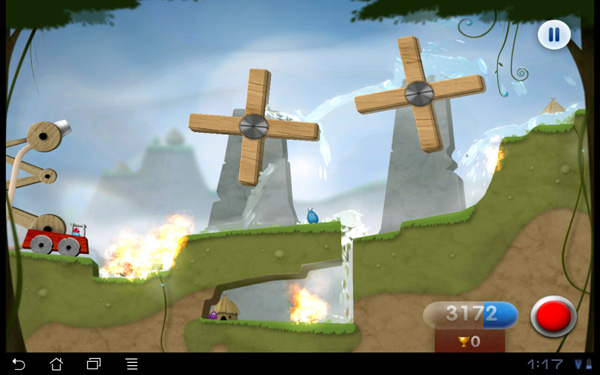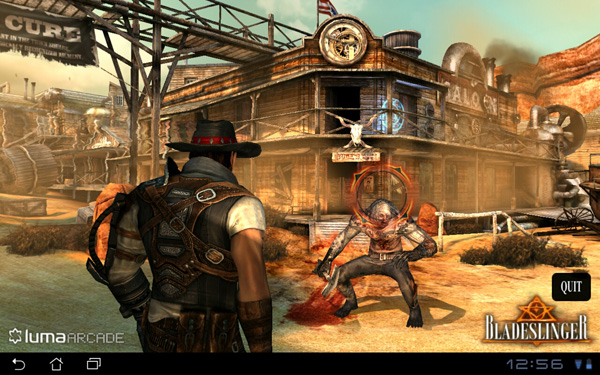ASUS Eee Pad Transformer Prime & NVIDIA Tegra 3 Review
by Anand Lal Shimpi on December 1, 2011 1:00 AM ESTHDMI Output, Controller Compatibility & Gaming Experience
NVIDIA sent along a Logitech Wireless Gamepad F710 with the Eee Pad Transformer Prime to test game controller compatibility. NVIDIA claims the Nintinendo Wiimote, wireless PS3, wired Xbox 360 and various other game controllers will work with Tegra 3 based devices courtesy of NVIDIA's own driver/compatibility work. The Logitech controller worked perfectly, all I had to do was put batteries in the device and plug the USB receiver into the Prime's dock; no other setup was necessary. Note that this same controller actually worked with the original Transformer as well, although there seemed to be some driver/configuration issues that caused unintended inputs there.
By default the Logitech controller navigates the Honeycomb UI just fine. You can use the d-pad to move between icons or home screens, and the start button brings up the apps launcher. The X button acts as a tap/click on an icon (yes, NVIDIA managed to pick a button that's not what Sony or Microsoft use as the accept button - I guess it avoids confusion or adds more confusion depending on who you ask).
Game compatibility with a third party controller is varied. NVIDIA preloaded a ton of Tegra Zone games on the Prime for me to get a good experience of what the platform has to offer. Shadowgun worked just like you'd expect it to, with the two thumbsticks independently controlling movement and aiming. Unfortunately the triggers aren't used in Shadowgun, instead you rely on the A button to fire and the B button to reload. Other games would use the d-pad instead of the thumbsticks for movement or use triggers instead of buttons for main actions. It's not all that different from the console experience, but there did seem to be more variation between control configurations than you'd get compared to what you find on the Xbox 360 or PS3.
The actual gaming experience ranges from meh to pretty fun depending on the title as you might expect. I'd say I had the most fun with Sprinkle and Riptide, with Bladeslinger looking the best (aside from NVIDIA's own Glowball demo).
Sprinkle is a puzzle game that we've written about in the past. You basically roll around with a fire truck putting out fires before they spread and catch huts on fire. It's like a more chill Angry Birds if you're not sick of that comparison. Sprinkle doesn't make use of external controllers, it's touch only.
Riptide is a jetski racing game that does have controller support. There's not a whole lot of depth to the game but it is reminiscent of simple racing games from several years ago. The Tegra version gets an image quality upgrade and overall the game doesn't look too shabby. I probably wasted a little too much time playing this one during the review process. It runs and plays very smoothly on Tegra 3.
Bladeslinger is the best looking title NVIDIA preloaded on the Prime - it's basically a Western themed Infinity Blade knockoff. Image quality and performance are both good, although the tech demo wasn't deep enough to really evaluate the game itself.
For games that support an external controller, the Logitech pad usually just worked. The only exception was Riptide where I had to go in and enable controller support in the settings menu first before I could use the Logitech in game. I don't believe that better third party controller support alone is going to make Android (or the Prime) a true gaming platform, but it's clear this is an avenue that needs continued innovation. NVIDIA wants to turn these tablets and smartphones into a gaming platform, and letting you hook up a wide variety of controllers up to them is a good idea in my book.
HDMI output was easy to enable; I just plugged the Prime into my TV and I got a clone of my display. I didn't have to fiddle with any settings or do anything other than attach a cable. The holy grail? Being able to do this wirelessly. The controller is there, it's time to make it happen with video output as well.












204 Comments
View All Comments
ATOmega - Tuesday, December 6, 2011 - link
Exactly my reasoning, and it's easy enough to see that the Transformer Prime boasts better features like GPS, camera and display.After having owned an iPad2, there must be a reason why I want this thing. And it's for all the things Apple decided to fleece me on so that they could jack up their margins.
I never liked Apple in the first place, but it's obvious they don't want to truly compete with the Android OS.
sigmatau - Thursday, December 1, 2011 - link
I was really hoping Nvidia would have something special with kal-el. This is pretty horrible when compared to hardware that has been available for about a year.It seems that the Nvidia-equiped tablets should be targeted at a much lower price point. They definetly should not be in the top tier tablets. I can see them selling at $300 or less.
UpSpin - Thursday, December 1, 2011 - link
Don't forget the display brightness. I don't think that the processor makes such a huge difference in power consumption, but the display on the Prime is much much brighter than the display of the iPad, and this will consume a huge amount of power. It's also brighter than the display of the first gen transformer, and the prime has a quad core and it gets the same or higher battery life than the first gen, I think that's really a big improvement.And if you want to use a tablet on the go, outside the house, you really need the brightest display possible. And as you can see in the picture, the difference between the sunlight visibility of the iPad and Prime is like day and night. Therefore I at least, sacrifice the 3 hours less battery life.
name99 - Thursday, December 1, 2011 - link
The display surely only uses more power if you drive it at a brighter level?And a well-designed tablet should have a light sensor, and should do a good job of auto-calibrating the brightness to the environment, so that most of the time it is NOT running the screen in bright mode. After all, that's what we expect regarding the core --- we throttle CPU when it's not needed. So, sorry, I don't think this is an acceptable answer.
I continue to state my original thesis --- I suspect that DRAM power is substantially more important than most people believe, and that one of Apple's advantages is that they ship iOS devices with minimal DRAM. This is obviously a hassle for developers, and even for some power users, but that's the tradeoff one has to make.
(Also what's the story with Android and VM? iOS does NOT do any "write" swapping --- code is paged in, but data is not paged out, and I expect that this is a power issue, nothing else --- Apple doesn't want the power hit of swapping.
I thought Android was like this --- did not write pages --- but I have read stuff recently that said no, it is now using standard desktop type VM, which is likely also a power sink.)
metafor - Thursday, December 1, 2011 - link
nVidia's solution is actually much more sophisticated than that. It's similar to a method Intel started using a ways back for laptops.It's not just auto-dimming the entire screen; it's auto-dimming every pixel individually. There is fine-grain control over the LED backlight of the display. Areas in each frame that contains black will now not only have the LCD crystal for that pixel in a "block" mode, but it will also have the backlight for that specific pixel dim.
This actually produces benefits other than just battery life; one of the biggest problems with LCD's is that blacks aren't really black because the crystal isn't able to block 100% of the backlight.
By dimming the backlight, the parts of an image that is supposed to be black will be closer to true black. This improves contrast and provides for more accurate pictures.
UpSpin - Friday, December 2, 2011 - link
how shall this work if the backlight is created by an LED array at the edge, which almost all smaller (<20") displays are. So with an edge lit backlight you can't reduce the LED brightness block wise.This is different if the used panel has a full array of LEDs, which is expensive, more power consuming and thicker, so a no go on a mobile device that thin. And neither Intel nor Nvidia have impact on this, because this requires a different panel.
TechAnandUser - Friday, December 2, 2011 - link
BenchMarking App's are not yet optimized. So please wait !!fteoath64 - Friday, December 2, 2011 - link
Why would you want a Win8 tablet ?. Its slow, heavy, short battery-life and probably cost 50% more!.You are better off with a mid-range slim laptop which you probably have. So unless you grab one of these or already have an ipad, you have no idea what a tablet can do for you.eddman - Friday, December 2, 2011 - link
You might have a time machine then, cause right now there are no win 8 tablets, let alone ARM based ones.tipoo - Thursday, December 15, 2011 - link
"Its slow, heavy, short battery-life and probably cost 50% more"Citation needed, citation needed, citation needed, and citation needed respectively. None of us have tested finalized W8 table hardware yet, unless you are from the future.